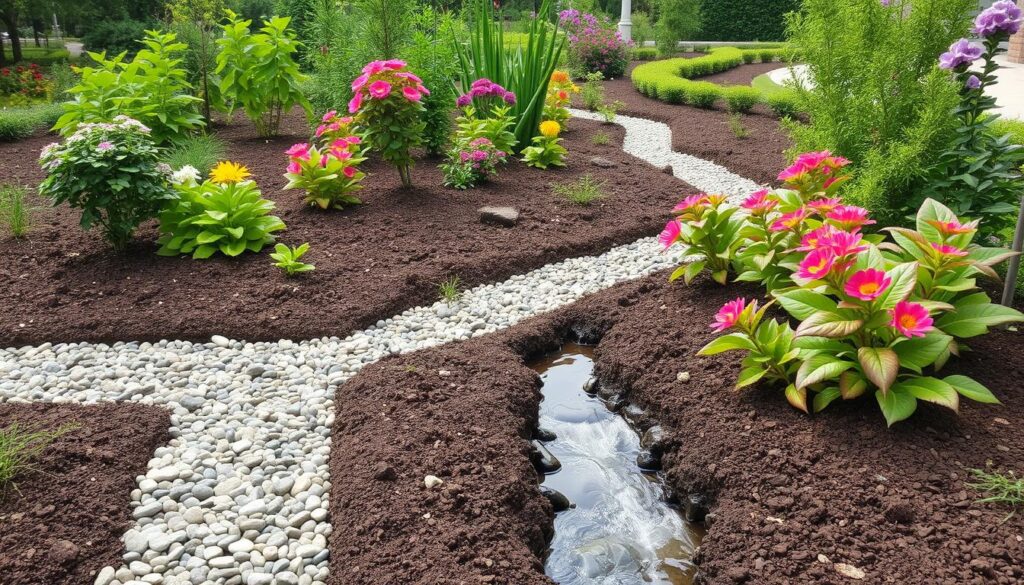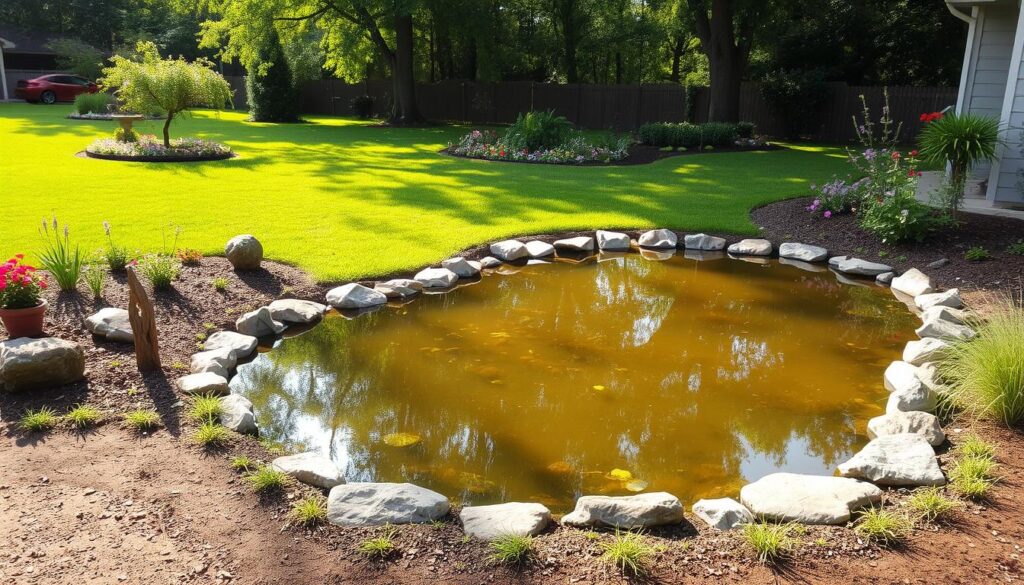Your yard’s health depends on effective water management. Proper landscape drainage is key to a beautiful and thriving outdoor space. If rainwater doesn’t drain away, your lawn can become soggy, plants die, and your foundation might be damaged.
Good drainage solutions protect your yard and home from water problems. They prevent erosion, keep soil healthy, and help plants grow well. Understanding the importance of landscape drainage is the first step to a healthier yard.
Investing in proper drainage is more than just avoiding problems. It’s about creating a yard that’s fun all year. With the right water management, you can say goodbye to muddy patches and hello to a lush, vibrant landscape that can handle any weather.
Why Proper Drainage in Landscaping Matters
Proper drainage is key to a healthy, beautiful outdoor space. It’s not just about avoiding puddles. It also protects your property, plants, and soil from damage.
Preventing Water Damage to Your Property
Effective drainage prevents water damage. Excess water near your home’s foundation can harm basements, crawl spaces, or even the structure. Proper drainage solutions protect your home, saving you money and keeping its value high.

Protecting Plant Health and Root Systems
Plant health depends on well-drained soil. Too much water can cause root rot, stunted growth, and plant death. Good drainage ensures your plants get the right water and oxygen. This leads to strong roots and healthy, vibrant plants in your landscape.
Maintaining Soil Structure and Stability
Soil stability is crucial for a thriving landscape. Proper drainage stops erosion, nutrient loss, and soil compaction. It keeps the soil structure right, allowing for better water and nutrient absorption. This creates the perfect environment for plant growth and supports your outdoor space’s health.
“A well-drained landscape is the foundation of a beautiful and resilient outdoor environment.”
By focusing on drainage, you’re investing in your property’s long-term health and beauty. This approach prevents water damage, boosts plant health, and improves soil stability.
Common Drainage Problems in Residential Landscapes
Your yard can face several drainage issues that affect its health and appearance. Let’s explore some common problems you might encounter in your residential landscape.

Standing water is a frequent concern for homeowners. After heavy rain, you might notice puddles that don’t seem to go away. This can lead to mosquito breeding grounds and damage your lawn’s root system.
Soil erosion is another issue that can plague your property. When water doesn’t drain properly, it can wash away topsoil. This exposes plant roots and creates unsightly bare patches in your yard.
- Muddy areas that never dry out
- Foundations at risk of water damage
- Plant die-off due to oversaturation
Waterlogged soil is a silent killer for your garden. It prevents oxygen from reaching plant roots, leading to root rot and stunted growth. You might notice yellowing leaves or wilting plants as telltale signs.
“A well-drained landscape is the foundation of a healthy, vibrant yard.”
Identifying these problems early can save you time and money in the long run. By addressing standing water, soil erosion, and waterlogged soil promptly, you’ll create a thriving environment for your plants. You’ll also have a beautiful outdoor space for your family to enjoy.
Essential Components of an Effective Drainage System
A good drainage system keeps your yard looking great. It’s all about managing water flow well. Let’s look at the main parts that make it work.
Surface Drainage Solutions
Surface drainage handles water on the ground. It means making your yard slope away from buildings. You also create swales, which are shallow ditches that lead water to safe spots.
Proper grading is key. It keeps water from pooling near your home’s foundation.
Subsurface Drainage Options
Subsurface drainage deals with water under the ground. French drains are a common choice. They use pipes with holes surrounded by gravel to collect and move groundwater.
These systems are great for areas with lots of water or clay soil. Clay holds onto water, making it hard to drain.
Catch Basins and Collection Points
Catch basins are key for collecting excess water. They’re underground boxes with grates on top. They catch runoff from the surface and filter out debris.
Then, they send the water to the right place. This stops flooding and erosion in your yard.
“A comprehensive drainage system combines surface and subsurface solutions with strategic collection points to ensure your landscape stays dry and healthy.”
With these key parts, you get a strong drainage system. It protects your property from water damage. And it keeps your outdoor space looking beautiful.
Types of Landscape Drainage Solutions
Choosing the right drainage solution is key to protecting your property and plants. Let’s look at some popular options to manage water effectively.
French Drains and Their Benefits
French drains are underground pipes with gravel around them. They move water away from your yard’s problem spots. These drains are great for fixing wet areas and preventing foundation damage.
Channel Drains and Surface Grates
Channel drains are ideal for areas with lots of water. They collect water and direct it to a specific spot. You’ll see them near driveways, patios, or pool decks.
Surface grates cover the channels, making them safe to walk on. They let water pass through.
Rain Gardens and Natural Solutions
Rain gardens are a natural way to handle water runoff. They’re shallow depressions filled with native plants. These plants soak up and filter rainwater.
Rain gardens are not just functional but also add beauty. They work well in low spots or near downspouts.
“Rain gardens are like nature’s sponges, soaking up excess water and creating a beautiful habitat for local wildlife.”
Each solution – French drains, channel drains, and rain gardens – has its own benefits. The best choice depends on your specific needs and landscape design. Think about your soil type, slope, and problem areas when deciding.
Planning Your Landscape Drainage Project
Starting a landscape drainage project means first doing a site assessment. Walk your property during rain to see how water moves. Look for where water gathers or causes erosion. This helps spot problem spots and shapes your drainage plan.
Then, do a water flow analysis. Sketch out your land’s natural slopes and contours. Figure out where water flows and where it ends up. This is key for a drainage system that fits your land’s natural flow.
Think about these important factors in your plan:
- Soil type and how well it absorbs water
- Existing plants and their roots
- Where buildings and hard surfaces are
- Local rules and permits needed
After assessing your site and analyzing water flow, pick the right solutions. You might need French drains, catch basins, or rain gardens. A good drainage system keeps your property safe and looks great.
“A successful landscape drainage project begins with careful planning and ends with a yard that’s both functional and aesthetically pleasing.”
With careful planning, you’ll have a water management system that works well. It will also keep your landscape beautiful for many years.
Professional Installation vs. DIY Drainage Solutions
Choosing between professional drainage and DIY can be hard. It depends on your project’s complexity and your skills. Let’s look at both options to help you decide.
When to Call a Professional
For complex projects, professional installation is best. If your yard has big slope issues or lots of water, experts are better. They have the skills and tools for tough jobs.
- You’re unsure about local regulations
- Your property has multiple drainage issues
- You lack the time or physical ability for a DIY project
Tools and Materials for DIY Installation
For simple projects, DIY can save money. You’ll need some basic tools:
- Shovel and pickaxe
- Perforated pipes
- Gravel
- Landscape fabric
- Level
Common DIY Installation Mistakes
DIY drainage can be rewarding but mistakes happen. Avoid these common errors:
- Incorrect slope calculation
- Using the wrong type of pipe
- Forgetting to call utility companies before digging
- Inadequate planning
Whether you go for professional or DIY, planning is crucial. Take time to understand your needs and abilities before starting.
Maintenance Tips for Landscape Drainage Systems
It’s important to keep your landscape drainage system in good shape. Regular maintenance prevents expensive repairs and protects your property from water damage.
Seasonal Maintenance Schedule
Make a plan for seasonal maintenance to keep your drainage system working all year:
- Spring: Clear debris from gutters and downspouts
- Summer: Trim vegetation around drainage areas
- Fall: Remove fallen leaves from drains and pipes
- Winter: Check for ice buildup in drainage channels
Cleaning and Inspection Guidelines
Do regular inspections to find problems early:
- Remove debris from catch basins and grates
- Flush pipes with water to clear blockages
- Check for signs of erosion around drainage outlets
- Inspect joints and connections for leaks
Troubleshooting Common Issues
Fix these common drainage problems quickly:
- Standing water: May indicate a clogged pipe or poor grading
- Slow drainage: Could be caused by debris buildup or root intrusion
- Erosion: Might require additional landscaping or redirection of water flow
By following these tips and doing regular inspections, your drainage system will work well for many years.
Cost Considerations and ROI of Drainage Solutions
Getting a good drainage system for your yard might seem pricey. The cost depends on your property’s size and how complex the drainage problem is. Usually, homeowners pay between $2,000 and $6,000 for a pro to install it.
Even though it costs a lot upfront, it’s worth it in the long run. A well-made drainage system can make your property value go up by 15%. This is because it stops water damage, erosion, and keeps your yard looking great.
- Reduced repair costs
- Lower maintenance expenses
- Increased property appeal
Over time, you’ll save a lot of money. You won’t have to spend thousands on fixing your foundation. You’ll also save on lawn care and replanting. A good drainage system keeps your outdoor areas beautiful and useful for many years.
“A properly installed drainage system is like insurance for your landscape. It protects your investment and brings peace of mind.”
Think about how a drainage system can increase your home’s value when you sell it. People are more likely to pay more for homes with nice yards and good drainage. So, your initial investment will pay off in the long run.
Conclusion
Proper landscape drainage is crucial for a thriving outdoor space. It protects your property from water damage and keeps plants healthy. Good drainage also maintains soil structure and prevents erosion, making your yard beautiful.
There are many ways to manage water in your landscape, like French drains and rain gardens. Each method has its own benefits for your specific needs. Whether you do it yourself or hire a professional, fixing drainage issues is a wise choice for homeowners.
Keeping your drainage system in good shape is an ongoing task. Regular maintenance ensures it works well all year. By investing in proper water management, you’re not just solving a problem. You’re also increasing your property’s value and making your outdoor space more enjoyable.
Good landscape drainage is about more than just moving water away. It’s about creating a balanced, healthy environment for your plants and soil. So, take action today to improve your landscape’s drainage. Enjoy the long-term benefits of effective water management.


